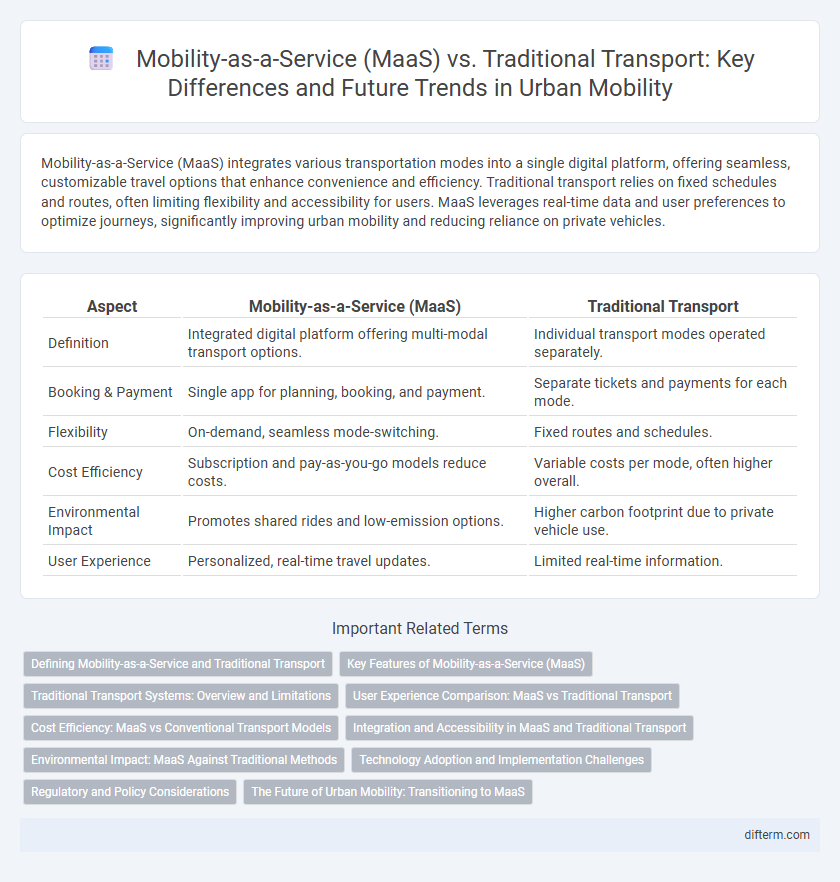Mobility-as-a-Service (MaaS) integrates various transportation modes into a single digital platform, offering seamless, customizable travel options that enhance convenience and efficiency. Traditional transport relies on fixed schedules and routes, often limiting flexibility and accessibility for users. MaaS leverages real-time data and user preferences to optimize journeys, significantly improving urban mobility and reducing reliance on private vehicles.
Table of Comparison
| Aspect | Mobility-as-a-Service (MaaS) | Traditional Transport |
|---|---|---|
| Definition | Integrated digital platform offering multi-modal transport options. | Individual transport modes operated separately. |
| Booking & Payment | Single app for planning, booking, and payment. | Separate tickets and payments for each mode. |
| Flexibility | On-demand, seamless mode-switching. | Fixed routes and schedules. |
| Cost Efficiency | Subscription and pay-as-you-go models reduce costs. | Variable costs per mode, often higher overall. |
| Environmental Impact | Promotes shared rides and low-emission options. | Higher carbon footprint due to private vehicle use. |
| User Experience | Personalized, real-time travel updates. | Limited real-time information. |
Defining Mobility-as-a-Service and Traditional Transport
Mobility-as-a-Service (MaaS) integrates various transportation modes such as ride-sharing, public transit, and bike rentals into a single digital platform, offering users seamless, on-demand travel solutions with real-time information and unified payment options. Traditional transport relies on separate, often disconnected systems like buses, trains, and personal vehicles, requiring individual planning and transactions for each mode. MaaS enhances convenience and efficiency by streamlining access and optimizing route choices, contrasting with the fixed schedules and infrastructure constraints typical of traditional transport.
Key Features of Mobility-as-a-Service (MaaS)
Mobility-as-a-Service (MaaS) integrates various transportation modes such as public transit, ride-sharing, bike rentals, and car-sharing into a single accessible platform, enhancing user convenience and flexibility. Real-time data and AI-driven route optimization enable personalized, seamless travel experiences that reduce dependency on private vehicles and lower carbon emissions. Subscription-based pricing models and centralized payment systems streamline costs and improve affordability compared to traditional transport methods.
Traditional Transport Systems: Overview and Limitations
Traditional transport systems rely heavily on fixed routes, schedules, and infrastructure such as buses, trains, and taxis, often leading to inefficiencies and limited flexibility for users. These systems face challenges including traffic congestion, outdated infrastructure, and high operational costs that hinder seamless mobility. The inflexibility and reliance on centralized planning contribute to reduced convenience and longer travel times compared to dynamic, demand-responsive solutions like Mobility-as-a-Service (MaaS).
User Experience Comparison: MaaS vs Traditional Transport
Mobility-as-a-Service (MaaS) offers a seamless, integrated platform combining multiple transport modes, enhancing user convenience and reducing the hassle of planning separate trips compared to traditional transport. Real-time data, personalized route options, and cashless payments improve user satisfaction and accessibility in MaaS, whereas traditional transport often involves fragmented information and multiple ticketing systems. The user experience in MaaS is characterized by efficiency and flexibility, addressing common pain points in traditional commuting such as inflexible schedules and limited connectivity.
Cost Efficiency: MaaS vs Conventional Transport Models
Mobility-as-a-Service (MaaS) reduces transportation costs by integrating multiple transport modes into a single, subscription-based platform that eliminates the need for private vehicle ownership. Traditional transport models often incur higher expenses through fuel, maintenance, and parking fees, which MaaS mitigates by promoting shared and on-demand usage. Data-driven route optimization and dynamic pricing in MaaS further enhance cost efficiency compared to static pricing and routing in conventional systems.
Integration and Accessibility in MaaS and Traditional Transport
Mobility-as-a-Service (MaaS) integrates multiple transport modes into a single accessible platform, streamlining trip planning, booking, and payment to enhance user convenience and efficiency. Traditional transport systems often operate in isolated networks with limited interoperability, creating barriers to seamless travel and reducing accessibility for diverse user needs. MaaS's digital integration facilitates real-time data sharing and personalized mobility options, significantly improving urban accessibility compared to the fixed routes and schedules of conventional transport.
Environmental Impact: MaaS Against Traditional Methods
Mobility-as-a-Service (MaaS) significantly reduces carbon emissions by integrating eco-friendly transportation modes such as electric vehicles, bikes, and public transit into a unified platform, promoting shared journeys over private car ownership. Traditional transport systems rely heavily on individual combustion-engine vehicles, leading to higher pollution levels and increased fossil fuel consumption. Studies show MaaS can lower urban air pollution and decrease greenhouse gas emissions by up to 30% compared to conventional transport methods.
Technology Adoption and Implementation Challenges
Mobility-as-a-Service (MaaS) leverages digital platforms and real-time data integration to offer seamless multimodal travel experiences, contrasting with traditional transport systems reliant on fixed routes and schedules. Significant technology adoption challenges include ensuring interoperability between diverse transport operators, securing user data privacy, and achieving widespread digital infrastructure coverage. Implementation hurdles also encompass managing legacy systems, overcoming regulatory constraints, and fostering user acceptance to drive mass adoption of MaaS solutions.
Regulatory and Policy Considerations
Regulatory frameworks for Mobility-as-a-Service (MaaS) prioritize data privacy, interoperability standards, and dynamic pricing models, contrasting with traditional transport's emphasis on fixed schedules and infrastructure regulation. Policies promoting MaaS integration focus on fostering innovation through flexible licensing and incentivizing multimodal connectivity, whereas traditional transport regulation often involves rigid compliance with established safety and operational protocols. The evolving legal landscape for MaaS includes addressing cybersecurity risks and equitable access, challenging policymakers to balance innovation with public safety and accessibility mandates.
The Future of Urban Mobility: Transitioning to MaaS
Mobility-as-a-Service (MaaS) integrates various transportation modes into a single digital platform, enhancing convenience and reducing reliance on private vehicles in urban areas. Unlike traditional transport systems, MaaS offers personalized, on-demand solutions that optimize route efficiency and minimize environmental impact through real-time data analytics. This transition supports sustainable urban development by promoting multimodal connectivity and decreasing carbon emissions.
mobility-as-a-service vs traditional transport Infographic

 difterm.com
difterm.com